Gender identity is often described as one’s personal notion of himself or herself as male or female, both or neither, whereas gender refers to societal constructed characteristics inclusive of customs, roles and relationships. These characteristics vary from society to society and in some societies, those who do not conform to those norms face stigma, stereotypes and social alienation.
Herbert Spencer in his social evolution theory noted that the society is moving from “simple to complex, homogenous to heterogeneous, simple to compound and from militant to industrial”. Furthermore, this theory highlights that compound societies are also characterized by industrial structures, which demonstrate an advancement in division of labor in reference to various societies. He states that doubly compound societies are more united and are characterized by a particular political structure, religious hierarchy hence complexity in terms of labor division. Spencer’s theory faced criticism whereby social thinkers claimed that this theory was inconsistent since some societies have not evolved and that being human is not only about struggle for existence since every society is characterised by qualities such as sympathy, kindness and love. Regardless of social thinker’s criticisms Spencer’s theory still served as a guiding principal for social evolution.
For the longest time, women were confined to domestic roles whereas, men were considered providers, however most countries have embraced championing for women empowerment through establishing laws that favor involvement of women in various spheres. Prior to the creation of resolution of 1325 by the United Nations Security Council (UNSC) in 2000, it was noted that war dynamics were changing and women continued to be excluded from participation in peace processes yet women and girls are vastly impacted by conflict and war hence their critical role in peacebuilding efforts. The resolution also affirmed that ‘peace and security are more sustainable when women are involved in prevention of violent conflict, relief and participate in post conflict recovery efforts with the aim to foster durable peace.
Resolution 1325 paved the way for additional resolutions including UNSCR 1820 created in 2008 recognizing sexual violence as a weapon of war, UNSCR 1888 enacted in 2009 obligating protection of women and girls during armed conflict and UNSCR 1889 established in 2009 encouraging the participation of women in the both peace processes and decision making. These resolutions have greatly contributed to the establishment of regional resolutions as well as tremendous achievements by various countries in terms of establishing laws that favor women as well as access to various opportunities. This shift backed by social evolution has led to an increase in cases of domestic violence.
Today’s society is characterized by complexities in power dynamics whereby both men and women strive for equality. In some society’s acceptance to share power between men and women has continued to cause a drift within the society hence affecting relationships as well as peace. Barriers to women’s participation in peace processes continue to be affected by their minimal participation in designing and implementing of post-conflict resolution and peacebuilding activities, lack of financial support for women’s organizations involved in peacebuilding and lack of attention regarding women’s specific needs.
When collective efforts are essential, women, in particular possess traits such as empathy, courage and adaptability to situations, which are key traits in solving conflict. Women are key players in establishing long lasting sustainable peace most especially since they are many in numbers, they are primary caretakers of families hence their roles in advocating for peace. If shared, power can contribute to the greater good of a society and Women as well as men both have a role to play in peacebuilding. It requires collective efforts to sustain peace and this process should not exclude any gender.
By Debby Karemera
Peacebuillding Practitioner and clinical psychologist


